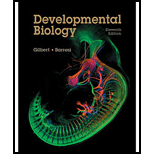
Concept explainers
To review:
Whether the hindlimb bud formation is autonomous or nonautonomous. Whether Hox and Islet1 gene expression supports the autonomous mechanism of hindlimb bud expression. Also explain the importance of time in influencing the hindlimb development.
Introduction:
The transcriptional basis of hindlimb bud formation is a well studied system, in relation to organogenesis. A number of signaling molecules regulates this process. The initiation of the vertebrate limbs involves the proliferation of lateral plate mesoderm (LPM), this proliferation initiate outgrowth with a signaling pathway from the LPM to ectoderm. The expression pattern of different genes and gene knockout mutations reveals and specify the identity of a limb region.
Explanation of Solution
In both forelimb and hindlimb bud formation, the fibroblast growth factor 10 (Fgf10) in the LPM activates the expression of another Fgf gene that is Fgf8, in the surface ectoderm. This expression maintains the formation of a mesenchymal Fgf10-ectodermal Fgf8 feedback loop to regulate the limb outgrowth. The genetic mechanism for the hindlimb initiation is still elusive in contrast with forelimb initiation. The two transcription factors Tbx4 and Pitx1 genes are highly expressed in the hindlimb field, but this expression is absent in forelimb field. But the experiment based on gene targeting indicates that neither is necessary for initiation of the hindlimb bud. There is a lack of data on the transcriptional regulation of hindlimb-specific initiation, compared to forelimb, where Tbx5 acts as transcriptional regulator.
Based on recent studies one important transcription factor gene Islet1, is found to be transiently expressed in the hindlimb field, but not in the forelimb field. Further lineage analysis indicates that Islet1-expressing cells forms a large part of the hindlimb mesenchyme. These analyses show Islet1, as a strong candidate to be a hindlimb-specific transcriptional regulator. Tbx4 expression is critical in the specification of hindlimb, just like the role played by Tbx5 in specification of forelimb. The limb field is also specified by the expression pattern of Hox gene. The activity of the limb bud also stimulates the creation and positive feedback retention of two signaling regions: the AER and its further creation of the zone of polarizing activity (ZPA) with the mesenchymal cells. Thus it can be assumed that signaling system critically control the temporospatial hindlimb formation, which are considered autonomous.
Thus it is concluded that a number of signaling molecules shows the critically regulated expression of different guidance hues for the hindlimb bud initiation, which are considered autonomous.
Want to see more full solutions like this?
Chapter 19 Solutions
Developmental Biology
- Which of the following is not a DNA binding protein? 1. the lac repressor protein 2. the catabolite activated protein 3. the trp repressor protein 4. the flowering locus C protein 5. the flowering locus D protein 6. GAL4 7. all of the above are DNA binding proteinsarrow_forwardWhat symbolic and cultural behaviors are evident in the archaeological record and associated with Neandertals and anatomically modern humans in Europe beginning around 35,000 yBP (during the Upper Paleolithic)?arrow_forwardDescribe three cranial and postcranial features of Neanderthals skeletons that are likely adaptation to the cold climates of Upper Pleistocene Europe and explain how they are adaptations to a cold climate.arrow_forward
- Biology Questionarrow_forward✓ Details Draw a protein that is embedded in a membrane (a transmembrane protein), label the lipid bilayer and the protein. Identify the areas of the lipid bilayer that are hydrophobic and hydrophilic. Draw a membrane with two transporters: a proton pump transporter that uses ATP to generate a proton gradient, and a second transporter that moves glucose by secondary active transport (cartoon-like is ok). It will be important to show protons moving in the correct direction, and that the transporter that is powered by secondary active transport is logically related to the proton pump.arrow_forwarddrawing chemical structure of ATP. please draw in and label whats asked. Thank you.arrow_forward
- Outline the negative feedback loop that allows us to maintain a healthy water concentration in our blood. You may use diagram if you wisharrow_forwardGive examples of fat soluble and non-fat soluble hormonesarrow_forwardJust click view full document and register so you can see the whole document. how do i access this. following from the previous question; https://www.bartleby.com/questions-and-answers/hi-hi-with-this-unit-assessment-psy4406-tp4-report-assessment-material-case-stydu-ms-alecia-moore.-o/5e09906a-5101-4297-a8f7-49449b0bb5a7. on Google this image comes up and i have signed/ payed for the service and unable to access the full document. are you able to copy and past to this response. please see the screenshot from google page. unfortunality its not allowing me attch the image can you please show me the mathmetic calculation/ workout for the reult sectionarrow_forward
 Biology 2eBiologyISBN:9781947172517Author:Matthew Douglas, Jung Choi, Mary Ann ClarkPublisher:OpenStax
Biology 2eBiologyISBN:9781947172517Author:Matthew Douglas, Jung Choi, Mary Ann ClarkPublisher:OpenStax Biology (MindTap Course List)BiologyISBN:9781337392938Author:Eldra Solomon, Charles Martin, Diana W. Martin, Linda R. BergPublisher:Cengage Learning
Biology (MindTap Course List)BiologyISBN:9781337392938Author:Eldra Solomon, Charles Martin, Diana W. Martin, Linda R. BergPublisher:Cengage Learning Biology: The Dynamic Science (MindTap Course List)BiologyISBN:9781305389892Author:Peter J. Russell, Paul E. Hertz, Beverly McMillanPublisher:Cengage Learning
Biology: The Dynamic Science (MindTap Course List)BiologyISBN:9781305389892Author:Peter J. Russell, Paul E. Hertz, Beverly McMillanPublisher:Cengage Learning Biology Today and Tomorrow without Physiology (Mi...BiologyISBN:9781305117396Author:Cecie Starr, Christine Evers, Lisa StarrPublisher:Cengage Learning
Biology Today and Tomorrow without Physiology (Mi...BiologyISBN:9781305117396Author:Cecie Starr, Christine Evers, Lisa StarrPublisher:Cengage Learning





